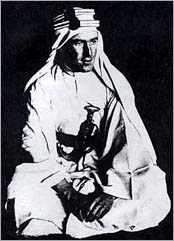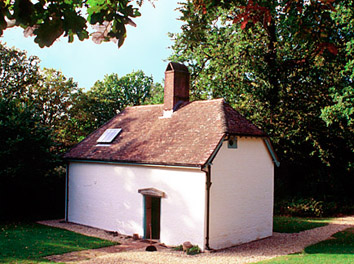
Lawrence of Arabia was made famous in the 1960's by David Lean's film. Right now you are listening to the main film theme. (You need a MIDI plug-in and sound card)

Lawrence of Arabia was made famous in the 1960's by David Lean's film. Right now you are listening to the main film theme. (You need a MIDI plug-in and sound card)
Thomas Edward Lawrence was born in Wales in 1888. He was the second of five illegitimate sons of Sir Thomas Chapman, an Anglo-Irish baronet, and Sarah Junner, who had previously been employed in the Chapman household as governess to Thomas's four legitimate daughters. Having eloped together, Thomas and Sarah adopted the name 'Lawrence'.
By 1896 they had settled in Oxford. T.E. attended the City of Oxford High School for Boys and studied History at Jesus College with First Class Honours, partly for a notable thesis on Crusader Castles, for which he did a lengthy walking tour in Palestine and Syria.
Fascinated by archaeology since childhood, after graduation he worked at an Hittite excavation on the River Euphrates. His responsibilities included photography, pottery, and managing the locally recruited workforce, a valuable skill later in his life.
After war broke out, Lawrence was posted at the Military Intelligence Department in Cairo where he became, among other things, an expert on Arab nationalist movements in the Turkish provinces that now comprise Syria, Lebanon, Israel, Jordan, and the Hedjaz region of Saudi Arabia. The quality of his reports and his empathy with Arab leaders led to a long-term role as a British liaison officer in the Arab Revolt against the Turks, serving with the forces led by the Emir Feisal.
His participation in the spring of 1917 in the interruption of the railway from Medina prevented the Turkish troops from leaving the city and reinforce their troops in Palestine, where they would have stopped the British advance. Lawrence barely allowed the Hedjaz railway to keep working whilst frequent guerrilla raids inflicted minor damage at remote points along the railway, halting traffic for a few days at a time. As a result, withdrawal from Medina was virtually impossible, and large numbers of Turkish soldiers and repair workers would be deployed along the line in order to defend it and keep it running. This strategy was put into effect and from that time on the Turkish force in Medina was impotent.
Soon after Lawrence played a crucial role in the conquest of the track from Akaba, which enabled the Arabs to move troops in order to extend their revolt to Damascus into Turkish territory. He raised a small group from the local population, which attacked the Wadi Itn mountain pass from the rear. To the astonishment of his colleagues, Lawrence crossed the dessert on a camelback, arriving at the British headquarters in Cairo to request urgent supplies. From that moment on the role of Lawrence in the war became increasingly influential. His next feat was the interruption of the Hedjaz railway and its branch into Palestine, which caused great damage to the Turks on their retreat.
Lawrence's account of the Arab revolt in "Seven Pillars of Wisdom" is borne out by British military documents now available.
Back in England Lawrence promoted the cause of Arab independence, in which he had come to believe passionately. He served in the British Delegation at the Paris Peace Conference in 1919, working closely with the Emir Feisal.
In 1919 when an American journalist, Lowell Thomas, arrived in London to write on the Arab's fight for freedom. He assembled a 'travelogue' which included lecture, slides, film, music, and dancing. This account of Lawrence's victories was a huge success in a country which was numbed by the horrors of European trench warfare. Lawrence quickly became a popular hero, and found that this gave added weight to his political campaign. This was the only period in his life when he actively sought publicity, giving interviews willingly in order to advance the Arab case.
To much of Lawrence's disappointment, at the end of the war the Middle East territories (Syria, Palestine and Iraq) were distributed as colonies between France and Britain. Lawrence then returned to England. He worked at Oxford as research fellow of All Souls College, and and spent some time in attic rooms lent to him by a friend at 14 Barton Street, in London. He had begun work on "Seven Pillars of Wisdom" while still in Paris, but his draft and working notes were stolen in the autumn of 1919. During 1920 he re-wrote the book from memory, and then began correcting it against all the sources he could find.
By the end of 1920, attempts to impose a British colonial administration in Iraq had provoked open rebellion. As a result, the British Government was having to spend huge sums on repression. Winston Churchill was appointed to the Colonial Office to find a solution. He persuaded Lawrence, who had been campaigning against Government policy in the press, to join him as adviser. Lawrence was instrumental in the accession of the Emir Feisal to the throne of Iraq, and in the foundation of the Kingdom of Trans-Jordan (later Jordan). Although still under British tutelage, both countries thereafter enjoyed a much greater degree of self-government. By the summer of 1922 Lawrence felt that, as far as it lay within Britain's power, Churchill had achieved an honourable settlement.
Lawrence was then in a perilous state of mind. The horrors of the wartime campaign had been followed by three wearisome years of politics, and then by the strain of writing a thousand-page book which he hoped would rank with "Moby Dick" and "The Brothers Karamazov". Fearing for his sanity, he resigned from the Colonial Office and sought refuge in the ranks of the RAF where he gave his name as 'John Hume Ross'. After four months he was discovered by the press and discharged.
Convinced that life in the ranks was his only course, and with the help of a highly-placed friends he re-enlisted almost immediately in the Tank Corps as 'Thomas Edward Shaw'. He served until mid-1925 at Bovington Camp in Dorset, during which time he found and rented a nearby cottage called Clouds Hill.

After the end of 1923, his free time and much of his energy was taken up revising a subscription edition of the "Seven Pillars of Wisdom" for which he employed two printers, and supervised every detail of the production. He spent so lavishly on colour portraits and other embellishments that by December 1926, when the book was finally completed, it had cost about £90 a copy. This was three times the subscription price. In order to repay his bank loan, he had to sanction general publication of an abridgement of "Seven Pillars" called "Revolt in the Desert".
During this time, Lawrence had succeeded in transferring back from the Tank Corps to the RAF. At the end of 1926 he accepted a posting to India, in order to be beyond the reach of journalists when "Revolt in the Desert" was published. Both "Revolt in the Desert" and "Seven Pillars" were hugely acclaimed, and Lawrence's bank loan was quickly paid off. He might have become wealthy, but he had made over all surplus royalties from the abridgement to a charity.
Encouraged by this literary success, during 1927 and 1928 Lawrence wrote another book, "The Mint", based on notes he had made during his first RAF enlistment. It is an unsparing yet brilliantly observed portrait of the initial training given to Air Force recruits. Chapter after chapter, he distilled into a few words mundane events that he had witnessed again and again. Like "One Day in the Life of Ivan Denisovich", it belongs to the genre of books written by intellectuals who find themselves, for one reason or another, in prison.
"The Mint" passed such harsh judgement on the RAF regime that publication would have damaged the reputation of the service Lawrence had come to love. He therefore stipulated that it should not appear before 1950.
After finishing "The Mint", he accepted a commission to translate Homer's "Odyssey". He did not complete it until 1932. Before then, at the end of 1928, he had been forced to return to England by fictitious press rumours about espionage activities in India.
He was then posted to a flying-boat unit at Plymouth. In his latest years he was deeply involved in the design and fabrication of planing-hull launches for the RAF. As a result, at the outbreak of World War II in 1939 the RAF was equipped with a fleet of high-speed launches. These were to save many thousands of lives during WW II.
In March 1935 his twelve-year term of enlistment came to an end. He retired to Clouds Hill, planning to start a private press and produce a small edition of The Mint. In Clouds Hill he undertook innovative construction methods such as tin foil on walls, cork insulation in the bathroom, etc.
In May 1935, while riding his motorcycle he swerved to avoid two cyclists and was thrown from his machine. He suffered severe head injuries and died some days later, having never regained consciousness.
